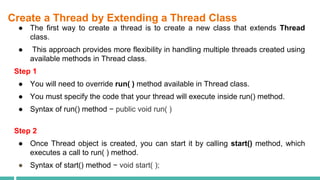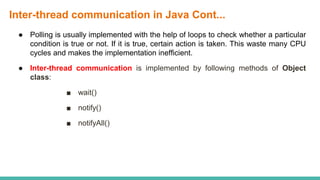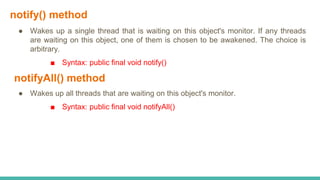Multithreading programming in java
- 1. Multithreading Programming in Java Elizabeth Alexander Hindustan University
- 2. Multithreading ● Multithreading is a Java feature that allows concurrent execution of two or more parts of a program for maximum utilization of CPU. ● Each part of such program is called a thread. ● Thread is basically a lightweight sub-process within a process ie, a smallest unit of processing. ● Multithreading is are used to achieve multitasking. ● In multithreading ,threads share a common memory area. They don't allocate separate memory area so saves memory, and context-switching between the threads takes less time than process. ● Java Multithreading is mostly used in games, animation etc.
- 3. Multithreading Cont... ● Multithreading is best in all cases in contrast with single-thread model. ● Single-thread system uses an approach of event loop with polling. ● A single thread in the system runs in an infinite loop. ● Polling the mechanism, that selects a single event from the event queue to choose what to do next. As the event is selected, then event loop forwards the control to the corresponding required event handler. Nothing else can be happened, until the event handler returns. ● Because of this CPU time is wasted. ● Here, only one part of the complete program is dominating the whole system, and preventing the system to execute or start any other process. ● In single-thread model one thread blocks all other threads until its execution completes.
- 4. Multithreading Cont... ● On other waiting or idle thread can start and acquire the resource which is not in use by the current thread. This causes the wastage of resources. ● Java's multithreading provides benefit in this area by eliminating the loop and polling mechanism, one thread can be paused without stopping the other parts of the program. If any thread is paused or blocked, still other threads continue to run. Advantages of Java Multithreading 1) It doesn't block the user because threads are independent and you can perform multiple operations at same time. 2) You can perform many operations together so it saves time. 3) Threads are independent so it doesn't affect other threads if exception occur in a single thread.
- 5. Thread in java ● A thread is a lightweight sub process, a smallest unit of processing. It is a separate path of execution. ● Threads are independent, if there occurs exception in one thread, it doesn't affect other threads. It shares a common memory area.
- 6. The Java Thread Model(Thread Life Cycle)
- 7. The Java Thread Model Cont... New/Ready to run ● A new thread begins its life cycle in the new state. ● First time as soon as it gets CPU time. ● It remains in this state until the program starts the thread. It is also referred to as a born thread. Runnable ● Under execution. ● After a newly born thread is started, the thread becomes runnable. ● A thread in this state is considered to be executing its task.
- 8. The Java Thread Model Cont... Waiting/Suspended ● Temporarily not active or under execution. ● Sometimes, a thread transitions to the waiting state while the thread waits for another thread to perform a task. ● A thread transitions back to the runnable state only when another thread signals the waiting thread to continue executing. Timed Waiting ● A runnable thread can enter the timed waiting state for a specified interval of time. ● A thread in this state transitions back to the runnable state when that time interval expires or when the event it is waiting for occurs.
- 9. The Java Thread Model Cont... Blocked ● Waiting for resources. Resumed ● Suspended thread resumed, and start from where it left off. Terminated (Dead) ● Halts the execution immediately and never resumes. ● A runnable thread enters the terminated state when it completes its task or otherwise terminates.
- 10. The Java Thread Model Cont...
- 11. Main thread in Java ● When a Java program starts up, one thread begins running immediately. This is usually called the main thread of our program, because it is the one that is executed when our program begins. Properties : ● It is the parent of all the threads of the program and all other "child" threads will be spawned from it. ● It must be the last thread to finish execution because it performs various shutdown actions How to control Main thread ● The main thread is created automatically when our program is started. ● To control it we must obtain a reference to the main thread. ● This can be done by calling a static method currentThread( ) which is present in Thread class.
- 12. Main thread in Java ● Its general form is static Thread currentThread( ) ● This method returns a reference to the thread on which it is called. ● The default priority of Main thread is 5 and for all remaining user threads priority will be inherited from parent to child.
- 13. Flow Diagram of Main Thread
- 14. Creating a thread ● Java defines two ways by which a thread can be created. ○ By implementing the Runnable interface. ○ By extending the Thread class. Thread class: ● Thread class provide constructors and methods to create and perform operations on a thread. ● Thread class extends Object class and implements Runnable interface. ● The Object class is the parent class of all the classes in java by default. In other words, it is the topmost class of java. Commonly used Constructors of Thread class: ● Thread() ● Thread(String name) ● Thread(Runnable r) ● Thread(Runnable r,String name)
- 15. Create a Thread by Extending a Thread Class ● The first way to create a thread is to create a new class that extends Thread class. ● This approach provides more flexibility in handling multiple threads created using available methods in Thread class. Step 1 ● You will need to override run( ) method available in Thread class. ● You must specify the code that your thread will execute inside run() method. ● Syntax of run() method − public void run( ) Step 2 ● Once Thread object is created, you can start it by calling start() method, which executes a call to run( ) method. ● Syntax of start() method − void start( );
- 16. Create a Thread by Implementing a Runnable Interface ● The easiest way to create a thread is to create a class that implements the runnable interface ● If your class is intended to be executed as a thread then you can achieve this by implementing a Runnable interface. Step 1 ● You need to implement a run() method provided by a Runnable interface. ● This method provides an entry point for the thread a ● You must specify the code that your thread will execute inside run() method. ● Syntax of the run() method − public void run( ) ● run() method can call other methods, can use other classes and declare variables just like any other normal method. Step 2 ● As a second step, you will instantiate a Thread object using the following constructor − Thread(Runnable threadObj, String threadName);
- 17. ● Where, threadObj is an instance of a class that implements the Runnableinterface and threadName is the name given to the new thread. Step 3 ● Once a Thread object is created, you can start it by calling start() method, which executes a call to run( ) method. ● Syntax of start() method − void start();
- 18. Thread Priorities ● In a Multi threading environment, thread scheduler assigns processor to a thread based on priority of thread. ● Whenever we create a thread in Java, it always has some priority assigned to it. ● Priority can either be given by JVM while creating the thread or it can be given by programmer explicitly. ● Accepted value of priority for a thread is in range of 1 to 10. ● There are 3 static variables defined in Thread class for priority. ○ public static int MIN_PRIORITY: This is minimum priority that a thread can have. Value for this is 1. ○ public static int NORM_PRIORITY: This is default priority of a thread if do not explicitly define it. Value for this is 5. ○ public static int MAX_PRIORITY: This is maximum priority of a thread. Value for this is 10.
- 19. Thread Priorities Cont... Get and Set Thread Priority: ● public final int getPriority(): java.lang.Thread.getPriority() method returns priority of given thread. ● public final void setPriority(int newPriority): java.lang.Thread.setPriority() method changes the priority of thread to the value newPriority. ○ This method throws IllegalArgumentException if value of parameter newPriority goes beyond minimum(1) and maximum(10) limit. Note: ● Thread with highest priority will get execution chance prior to other threads. Suppose there are 3 threads t1, t2 and t3 with priorities 4, 6 and 1. So, thread t2 will execute first based on maximum priority 6 after that t1 will execute and then t3. ● Default priority for main thread is always 5, it can be changed later. Default priority for all other threads depends on the priority of parent thread.
- 20. Synchronization in Java ● Multi-threaded programs may often come to a situation where multiple threads try to access the same resources and finally produce erroneous results. ● For example, if multiple threads try to write within a same file then they may corrupt the data because one of the threads can override data or while one thread is opening the same file at the same time another thread might be closing the same file. ● So it needs to be made sure by some synchronization method that only one thread can access the resource at a given point of time.This is implemented using a concept called monitors. ● Each object in Java is associated with a monitor, which a thread can lock or unlock. Only one thread at a time may hold a lock on a monitor.
- 21. Synchronization in Java Cont... ● Java programming language provides a way of creating threads and synchronizing their task by using synchronized blocks. We keep shared resources within this block. ● Synchronized blocks in Java are marked with the synchronized keyword. ● All synchronized blocks synchronized on the same object can only have one thread executing inside them at a time. ● All other threads attempting to enter the synchronized block are blocked until the thread inside the synchronized block exits the block. ● General form of a synchronized block: synchronized(sync_object) { // Access shared variables and other // shared resources }
- 22. Synchronization in Java Cont... ● Here, the sync_object is a reference to an object whose lock associates with the monitor that the synchronized statement represents. ● Synchronization in java is the capability to control the access of multiple threads to any shared resource. ● Java Synchronization is better option where we want to allow only one thread to access the shared resource. Why use Synchronization ● The synchronization is mainly used to ■ To prevent thread interference.:Interference occurs when two operations , running in different threads , but acting on the same data ■ To prevent consistency problem. : Consistency Errors occurs when different threads have inconsistent views of the shared data.
- 23. Inter-thread communication in Java ● Inter-thread communication or Co-operation is about allowing synchronized threads to communicate with each other. ● In concurrent programming, concurrent accesses to shared resources can lead to unexpected or erroneous behavior, so parts of the program where the shared resource is accessed are protected. This protected section is the critical section or critical region ● Inter-thread communication is a mechanism in which a thread is paused running in its critical section and another thread is allowed to enter (or lock) in the same critical section to be executed. ● Java uses Inter-thread communication or Co-operation to avoid polling. ○ The process of testing a condition repeatedly till it becomes true is known as polling.
- 24. Inter-thread communication in Java Cont... ● Polling is usually implemented with the help of loops to check whether a particular condition is true or not. If it is true, certain action is taken. This waste many CPU cycles and makes the implementation inefficient. ● Inter-thread communication is implemented by following methods of Object class: ■ wait() ■ notify() ■ notifyAll()
- 25. wait() method ● Causes current thread to release the lock and wait until either another thread invokes the notify() method or the notifyAll() method for this object, or a specified amount of time has elapsed.
- 26. notify() method ● Wakes up a single thread that is waiting on this object's monitor. If any threads are waiting on this object, one of them is chosen to be awakened. The choice is arbitrary. ■ Syntax: public final void notify() notifyAll() method ● Wakes up all threads that are waiting on this object's monitor. ■ Syntax: public final void notifyAll()
- 28. Concept of Lock in Java ● Synchronization is built around an internal entity known as the lock or monitor. ● Every object has a lock associated with it. ● By convention, a thread that needs consistent access to an object's fields has to acquire the object's lock before accessing them, and then release the lock when it's done with them. Deadlock in java ● Deadlock in java is a part of multithreading. Deadlock can occur in a situation when a thread is waiting for an object lock, that is acquired by another thread and second thread is waiting for an object lock that is acquired by first thread. ● Since, both threads are waiting for each other to release the lock, the condition is called deadlock.































































































![Présentation_gestion[1] [Autosaved].pptx](https://cdn.slidesharecdn.com/ss_thumbnails/prsentationgestion1autosaved-250608153959-37fabfd3-thumbnail.jpg?width=560&fit=bounds)











